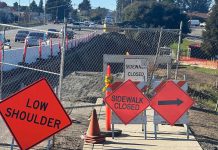
In two decades, Santa Cruz County transportation officials envision a 22-mile, cross-county rail-trail system that could transport an estimated 4,200 passengers between nine stations and, presumably, hook into the rail system in Pajaro that could connect to the greater Bay Area public transportation system.
The Zero Emission Passenger Rail and Trail (ZEPRT) Final Project Concept Report released on Oct. 24 by the Santa Cruz County Regional Transportation Commission outlines this ambitious $4.2 billion plan, a 323-page tome that covers the project’s cost, ridership and environmental impacts, among other things.
“This report represents an important step forward in understanding what zero-emission passenger rail could mean for Santa Cruz County,” said RTC Executive Director Sarah Christensen. “It provides our community and decision-makers with the facts needed to thoughtfully consider how this system might enhance mobility, sustainability, and access for all. Our goal has always been to plan responsibly and transparently, and this study gives us the foundation to do exactly that.”
The Project proposes to develop 12 miles of the Coastal Rail Trail from Rio Del Mar Boulevard through the community of La Selva Beach and the city of Watsonville, and rebuild the Capitola Trestle.
There would be stations in Pajaro, Watsonville, Aptos, Cabrillo College, Capitola, 17th Avenue, Seabright, downtown Santa Cruz and Natural Bridges Drive.
The RTC will discuss the report at its meeting in December.
The idea of a passenger rail system has transportation advocates buoyant about a train that would run about every 30 minutes and boast a 45-minute end-to-end trip when it is completed in roughly 2045.
But opponents—of which there are many—are skeptical of the project, saying it is unworkable both practically and financially. Among other things, they point to the estimated annual operating expenses of $34–$41 million, far above the price tag originally pitched to the public when they rejected a 2022 measure that would have directed the county to focus on a trail-only plan.
“The RTC appreciates the community’s patience as our staff has invested significant time in producing a high-quality and thorough final report,” Christensen said. “In the interest of public transparency, the RTC assures the community that this report dated October 24, 2025, has not been previously shared or distributed outside of the RTC.”Read the full Final Project Concept Report located at sccrtc.org/zeprt under the “Resources” section.












Looks like democrats next money-laundering scheme. How’s that $20billion dollar train to nowhere in the Central Valley going? How’s much of that money has been funneled elsewhere?
This will never happen.
The final paragraph was issued by the RTC because of the rail lobbying group FORT sent a newsletter to their supporters saying they had the report early and were analyzing it before the RTC released it to the public. Whether that was true or not remains to be seen, but all the unanswered questions still but defined in the report with additional billions of dollars of work around the Boardwalk and Watsonville with no plan for paying for this is a serious red flag.
NO ONE can match the money laundering schemes of the MAGA RETHUGLICANS. HIS PROSTITUTE PALACE TO REPLADE OUR BEAUTIFUL HISTORICAL EAST WING OF THE WHITE HOUSE IS ALL PAID FOR BY HIS CRIMINAL CROOKED FRIENDS. AND THE $50 THOUSAND IN A BRIEFCASE TAKEN BY HIS ASSISTANT ICE DIRECTOR? WHAT INCREDIBLE CORRUPTION!
AS TO THE RTC REPORT, I LIKE IT. AND YES, IT WILL HAPPEN. BUT LIKE ANY INFRASTRUCTURE, IT WILL TAKE LONGER AND MORE MONEY THAN EXPECTED. BUT WE NEED IT FOR OUR GROWTH AND TO STAY CONTERMPORARY IN THE 21ST CENTURY !